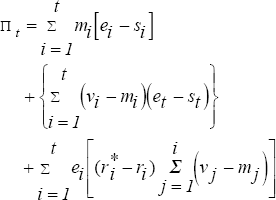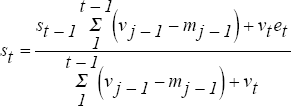RDP 9406: Reserve Bank Operations in the Foreign Exchange Market: Effectiveness and Profitability 3. The Profitability of Reserve Bank Intervention
November 1994
- Download the Paper 128KB
3.1 Overview of the Bank's Operations
The Bank's operations in the foreign exchange market can be thought of as comprising two main components. The first is pure intervention, over which the Bank has discretion as regards to size and timing. The second is client business, which consists of meeting the foreign exchange needs of its clients, principally the Commonwealth Government.[9] The timing and size of sales to clients is determined by the clients themselves, and therefore might be thought of as not at the Bank's discretion. However, the Bank chooses when to enter the market to restore the reserves of foreign exchange it has sold to clients. The second leg of the client business is therefore at the Bank's discretion.[10] Because client business involves a discretionary element, it should therefore be added together with pure intervention to calculate the total effect of the Bank's actions on the exchange rate. All the following calculations are based on figures which aggregate the two components.
Figure 3 shows the Bank's net purchases of foreign currency in the market and the net amount of foreign currency sold to the Government in each financial year since the float. Both are defined as positive numbers to facilitate comparison between the Bank's transactions in the market and client needs. Only in two years – 1988/89 and 1990/91 – did transactions in the market offset client needs. In the early post-float period, the Bank sold foreign currency in the market and sold to the Government. The consequential fall in reserves was reversed in the late 1980s when purchases in the market ran well ahead of sales to the Government. In more recent years, the Bank has reverted to being a seller both in the market and to the Government.[11]

Figure 4 shows the cumulative net foreign currency position of the Bank resulting from its transactions with the market and with clients since the float. It is measured in terms of US dollars – a positive number shows the Bank has bought more foreign currency from the market and/or its clients than it has sold. As noted, in the three years immediately following the float, the Bank was a net seller of foreign currency with the “short” position reaching around $US7 billion by the latter half of 1986. Soon after, the Bank switched to being a purchaser of foreign currency reflecting, first, a desire to rebuild reserves, and then intervention aimed at resisting the extent of the Australian dollar appreciation. By late 1988, the Bank's net foreign currency position had returned to square. The position fluctuated around zero for a time, before the sharp depreciation of the Australian dollar around the end of 1991 saw the Bank's sales of foreign exchange increase significantly. As at end-June 1994, the Bank had a cumulative “short” position totalling $US14.8 billion.

These calculations of the Bank's foreign exchange position only reflect the ‘discretionary’ element, i.e. the purchases and sales of foreign exchange. Throughout the period, however, there was another important influence at work, namely, the earnings on official reserves. These amounted to around $US8 billion in total and accrued continuously over the period. The dotted line in Figure 4 shows what the total foreign exchange position would be if these inflows were included. For the purposes of calculation of profit and loss, however, it is the ‘discretionary’ element given by the solid line that is important.
3.2 Methodology and Data
3.2.1 Sample Period and Data
This study uses data on the actual deals undertaken by the Bank (volumes and exchange rates). The sample period runs daily from 12 December 1983 to 30 June 1994.
The bulk of the Bank's intervention involves buying or selling US dollars against the Australian dollar on a spot basis; as a consequence, the analysis measures foreign exchange transactions in US dollars.[12] Where the Bank undertook a transaction with either the market or a client that involved the exchange of Australian dollars for a foreign currency other than the US dollar, this was recalculated in equivalent US dollars using an appropriate exchange rate. In some cases this was the actual foreign currency/US dollar exchange rate at which the deal was undertaken as deals are often crossed through the US dollar. Where the foreign currency/US dollar rate was not known for individual transactions it was proxied using the average exchange rate at which other deals were carried out on that day, or if that was not available, the exchange rate at 4.00 pm on that day. Outright forward transactions were rare throughout the period, though where they were identified, the forward rate was adjusted for the effect of interest rate differentials to arrive at a comparable spot rate.
3.2.2 Net Interest Income
As noted above, many argue that a full assessment of the profitability of foreign exchange intervention requires that the effect on net interest income be taken into account. Since it is a cost of holding one currency instead of another, it is clearly one of the variables which determines profitability. On the other hand, it can be argued that the effects on net interest income are purely incidental for a central bank which aims to exert a stabilising influence on its exchange rate. They should not, in any way, impinge upon the decision of whether to intervene, and therefore, should be excluded from the profit calculation. This argument has some merit to the extent that profits should not affect a decision to intervene.
In our view, there is not a clear answer to the question of whether interest earnings should be included in profit calculations. To our knowledge, most central banks intervene with the main objective of stabilising their exchange rate; they do not take portfolio considerations into account. In this respect, the most appropriate test of whether they met these objectives is to focus solely on trading profits. On the other hand, it could be claimed that net interest earnings should be taken into account to put central banks on the same footing as private sector speculators who have to take portfolio funding decisions into account.
In what follows, we present the figures for profits both including and excluding net interest income. It is worth repeating the earlier point, however, that taking account of net interest income usually works in the central bank's favour. Contrary to popular perceptions, therefore, the “trading profits” test is normally a harder one to pass than one that looks at total profits including net interest earnings.
The effect on net interest income is measured using the difference between the rate on an Australian 13-week treasury note and a US 3-month treasury bill rate. These are reasonable proxies for the interest rates available to the Bank as, at least until recently, the Bank tended to hold mainly short-term assets. The interest differential is applied to the net open currency position held by the Bank as a result of its foreign exchange operations.
3.2.3 Methodology
We have followed a similar procedure to that used by Murray, Zelmer and Williamson in their study of profitability for the Canadian experience. Profits from the Bank's foreign exchange operations at any point of time are calculated by:
where:
| vi | is the addition to an existing US dollar position, with vi > 0 for purchases of US dollars in a long position and vi < 0 for sales of US dollars in a short position; |
| mi | is the reduction in an existing US dollar position, with mi > 0 for sales of US dollars in a long position and mi < 0 for purchases of US dollars in a short position; |
| ei | is the exchange rate at which a transaction is made in terms of the number of Australian dollars per US dollar; |
ri and  |
are the short-term interest rates on Australian dollar and US dollar assets respectively; and |
| st | is the weighted average exchange rate at which the position is acquired and, for period t, is calculated as: |
The three components on the right hand side of the above formula can be interpreted as follows:
- the first calculates the realised trading profit during the period;
- the second is a measure of the unrealised trading profit. It simply revalues any existing US dollar position using the exchange rate at the end of the period; and
- the third is a measure of net interest earnings from holding a long US dollar (short Australian dollar) position compared with holding the equivalent in Australian dollars.
Note that there is a distinction made between a transaction that adds to an existing US dollar position, vi, and a transaction that partially reverses a position, mi. If a transaction adds to an existing US dollar position, the average exchange rate at which that position was acquired is recalculated so as to include that new transaction. At that point, there is no effect on profits. It is only when the position is reversed that trading profits or losses are realised. Realised profits/losses are calculated by comparing the exchange rate at which these US dollars are bought/sold to close out a position with the average exchange rate at which the position was acquired. At the end of the period, the unrealised profit or loss on the remaining open position can be measured by comparing the cost of establishing that position and the prevailing exchange rate.
A simple example best illustrates. Suppose the Bank initially purchases foreign currency and builds up a long US dollar position. As it continues to buy US dollars, the average exchange rate at which its long position has been acquired is recalculated. (In this case, the average exchange rate is an average purchase price.) Profits or losses are realised only when the position is reversed by selling US dollars. If the exchange rate at which the US dollars are sold is higher than the average cost at which they were acquired, then there is a realised profit on this transaction. If selling of US dollars is sustained, it gradually reverses the long US dollar position, resulting in profits/losses being realised until the position is fully closed out. Once closed out, further sales of US dollars open a short US dollar position and the average exchange rate at which this position has been acquired is an average selling price. Profits/ losses are realised on this short US dollar position only when US dollars are purchased. Finally, at the end of the period, unrealised profits on the outstanding US dollar position are calculated using the end-of-period exchange rate.
Footnotes
There is a third form of Reserve Bank operation in the foreign exchange market which involves changing the foreign currency position of reserves. For example, the Bank may sell US dollars to buy yen. Since these transactions are in “third currencies”, i.e. they do not involve an Australian dollar leg, they do not affect the value of the Australian dollar and are not included in these calculations. [9]
If the Bank chose to purchase in the market, at the time of receiving the client order, the exact amount of the order, then the Bank would exert no discretionary effect on the market. The outcome would be the same as if the client had gone directly to the market to meet its foreign exchange needs. [10]
Note that in 1993/94, the government was a net seller of foreign currency to the Bank, reflecting its program of swapping Australian dollar liabilities into US dollar liabilities. [11]
Spot transactions are settled within 2 business days from the day they are arranged; forward deals are those transactions which are arranged more than 2 business days before settlement. [12]

